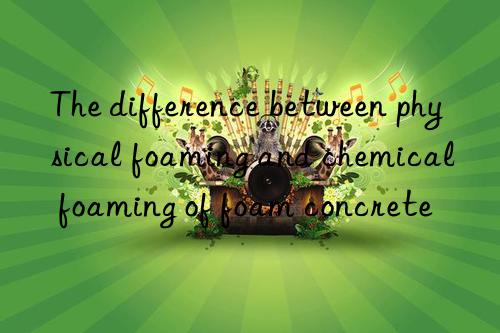
When physical foaming is used, the sample takes a long time to solidify, but the internal cells are small, uniform in size, high in sphericity, low in connectivity between cells, low in water absorption and high in strength.
When the chemical foaming method is used, the sample has a short coagulation time, but the internal cells are large, the pore sizes are different, the shape is irregular, the connectivity between cells is high, the sample has high water absorption and low strength. .
The key difference between the chemical foaming method and the physical foaming method is that the chemical reaction of substances produces new gas for foaming. The main feature of chemical foaming is that the bubbles have no bubble walls and poor stability, so they must Only the hydration products of cement and other materials can exist stably as the base material, and the size of the bubbles changes with the pressure and the amount of foaming material, making it difficult to control. However, the chemical foaming method has huge advantages for low-density foam concrete in terms of strength, water absorption and other properties.
When physical foaming is used, the system is in a relatively stable state, and the foaming agent has a good foam stabilizing effect. The internal cell structure of the sample is good, and the internal cells of the prepared sample are small and uniform in size. , high sphericity and low connectivity between cells. However, because the physical foaming agent has a strong retarding effect, at the same density, the demoulding time of the sample made by physical foaming is long; when chemical foaming is used , the entire system is in an unstable state, and the foaming speeds in different parts of the slurry are inconsistent. Therefore, the sizes of bubbles generated in the slurry are different. As the gas inside the slurry gradually increases, the liquid film between the bubbles in the slurry also changes. As it gets thinner and thinner, the phenomenon of small bubbles exhausting into large bubbles intensifies, causing large and small bubbles to connect with each other, and the small bubbles gradually become smaller or even disappear, resulting in a poor internal cell structure of the sample.
It is easy for the cells to connect to each other inside the sample produced by the chemical foaming method, which provides a penetration channel for water. Therefore, the water absorption rate of the chemical foaming sample is significantly higher than that of the physical foaming sample. . The interconnection of the internal cells of the chemical foam sample and the uneven cell diameter cause stress concentration on the connected cells and large cells when the sample is pressed, resulting in a reduction in the strength of the sample. This difference is mainly due to the foaming Due to different bubble mechanisms. However, chemical foaming has lower requirements for foam stabilizers than physical foaming. With the same foam stabilizer, the quality of foamed concrete produced by chemical foaming is better than that of physical foaming. The foamed concrete foamed by chemical foaming method The diameter is generally between 1-3mm, which is much larger than the pore diameter of physically foamed foam concrete. Therefore, its bubble wall is thicker and feels harder, especially at low density.
</p

 微信扫一扫打赏
微信扫一扫打赏

